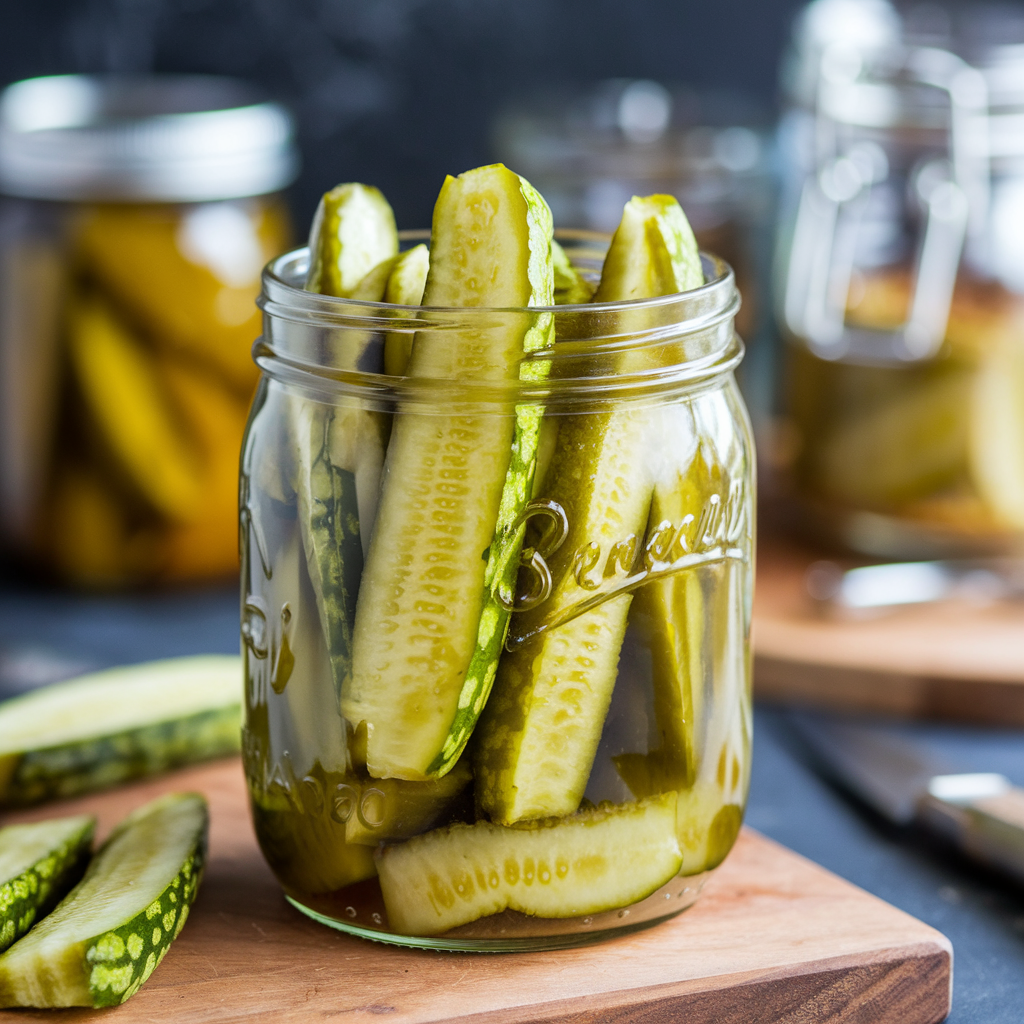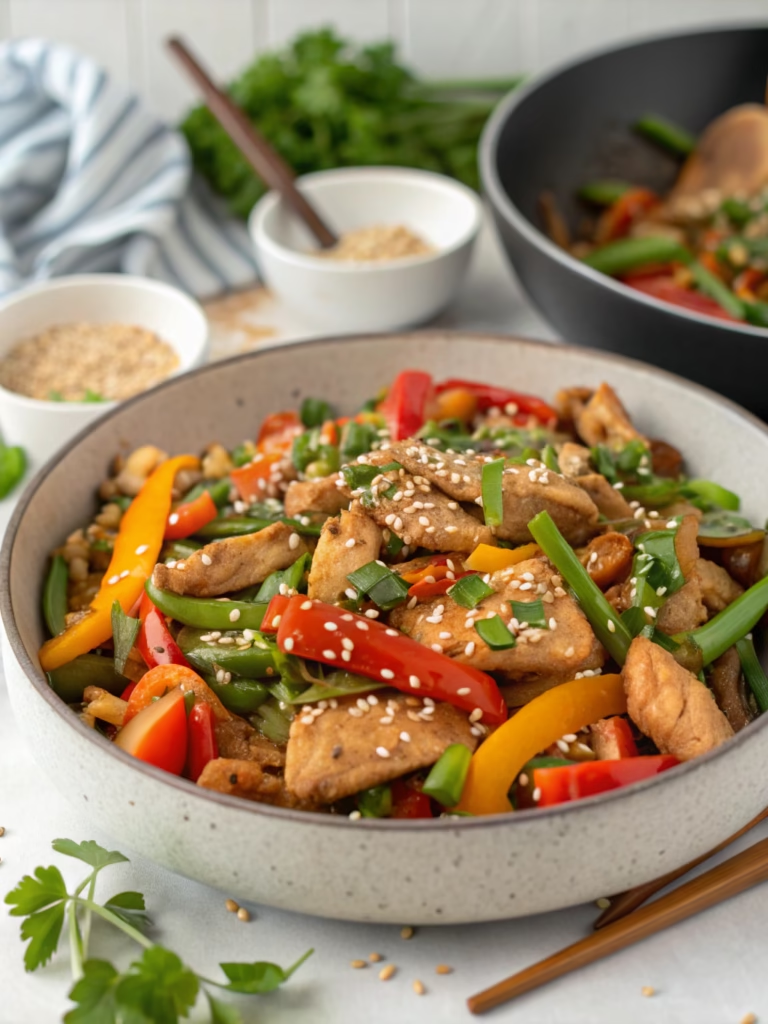Classic Watermelon Rind Pickles (Better Than Store-Bought!)
Table of Contents
Introduction
Did you know that Americans throw away over 1.3 billion pounds of watermelon rinds every summer? That’s a staggering amount of potential culinary treasure going straight to the trash! What if I told you that those discards could become the star of your next picnic or charcuterie board? Classic Watermelon Rind Pickles (Better Than Store-Bought!) are not just a delicious Southern tradition but also a brilliant way to Transform watermelon scraps into treasure! This sweet pickle recipe transforms what most people discard into a crunchy, tangy-sweet delicacy that will have your guests asking for your secret.
Ingredients

- Rind from 1 large watermelon (approximately 8 cups), white part only with green skin removed
- 4 cups granulated sugar
- 2 cups apple cider vinegar
- 1 cup water
- 1 lemon, thinly sliced
- 8 whole cloves
- 2 cinnamon sticks
- 1 teaspoon whole allspice berries
- 1 tablespoon kosher salt
- 1 piece fresh ginger (2 inches), peeled and sliced
Substitution Options:
- Replace apple cider vinegar with white vinegar (though this will yield a sharper flavor)
- Brown sugar can substitute for up to half of the white sugar for deeper molasses notes
- Star anise can replace allspice for a more exotic flavor profile
- Pink Himalayan salt can replace kosher salt
Timing
- Preparation Time: 45 minutes (includes removing rind and preparing brine)
- Brining Time: 8 hours or overnight
- Cooking Time: 25 minutes
- Processing Time: 10 minutes
- Total Time: 9-10 hours (33% of which is active cooking time)
Step-by-Step Instructions
Step 1: Prepare the Watermelon Rind
Remove the pink flesh from the watermelon, saving it for other uses. Carefully slice away the green outer skin, leaving only the white rind. Cut the rind into 1-inch cubes or your preferred shape. You should have approximately 8 cups of rind.
Pro Tip: Use a vegetable peeler for removing the green skin—it gives you more control and wastes less of the valuable white portion.
Step 2: Brine the Rinds
Place the rind pieces in a large bowl and dissolve 1 tablespoon of kosher salt in 2 quarts of cold water. Pour this over the rinds until completely submerged. Cover and refrigerate for at least 8 hours or overnight.
Pro Tip: Adding a few ice cubes to the brine helps maintain crispness in your final watermelon rind pickles.
Step 3: Make the Pickling Syrup
In a large, non-reactive pot, combine sugar, vinegar, water, lemon slices, cloves, cinnamon sticks, allspice berries, and ginger. Bring to a boil, stirring until sugar dissolves completely. Reduce heat and simmer for 5 minutes to allow the flavors to meld.
Pro Tip: Taste your syrup and adjust sweetness or tanginess now—it’s much harder to correct once the rinds are added.
Step 4: Cook the Rinds
Drain and rinse the brined watermelon rinds thoroughly. Add them to the simmering pickling syrup. Return to a simmer and cook until the rinds are translucent and tender when pierced with a fork, approximately 20-25 minutes.
Pro Tip: Test a piece every few minutes after the 15-minute mark—overcooked rinds lose their delightful crunch.
Step 5: Pack and Process (Optional)
Using tongs, carefully transfer the hot rinds into sterilized jars, leaving 1/4-inch headspace. Strain the pickling liquid through a fine-mesh sieve and pour over the rinds. Remove air bubbles, wipe jar rims, and seal with lids and bands.
For longer storage, process in a water bath for 10 minutes. Otherwise, allow to cool completely before refrigerating.
Nutritional Information
Per 1/4 cup serving:
- Calories: 87
- Carbohydrates: 22g
- Sugars: 21g
- Fiber: 0.5g
- Protein: 0.2g
- Fat: 0.1g
- Sodium: 98mg
- Vitamin C: 3% of Daily Value
- Calcium: 1% of Daily Value
Healthier Alternatives for the Recipe
- Reduce sugar to 3 cups and add 1/2 cup of monk fruit sweetener for a 25% reduction in calories
- Use a natural stevia-erythritol blend in place of half the sugar
- Add 1 teaspoon of turmeric to the pickling liquid for anti-inflammatory benefits
- Incorporate 1/4 cup of apple juice to enhance natural sweetness while reducing added sugar
Serving Suggestions
These Classic Watermelon Rind Pickles (Better Than Store-Bought!) are incredibly versatile:
- Serve alongside sharp cheeses on a charcuterie board
- Chop and add to chicken salad for sweet crunch
- Use as a unique sandwich topper for ham or turkey
- Dice and incorporate into relish for grilled meats
- Serve alongside spicy barbecue as a cooling counterpoint
Common Mistakes to Avoid
- Leaving the green skin on: This creates bitter flavors and tough texture
- Skipping the brining step: Critical for achieving the perfect crunch
- Overcooking the rinds: Results in mushy pickles—aim for tender-crisp
- Rushing the cooling process: Patience yields better flavor development
- Using iodized salt: Can create cloudiness and off-flavors in your pickles
Storing Tips for the Recipe
- Refrigerated pickles will keep for up to 3 weeks in airtight containers
- Properly water-bath canned pickles remain shelf-stable for 12-18 months
- Allow pickles to cure for at least 24 hours before eating for best flavor
- Store opened jars in the refrigerator and consume within 3 weeks
- Freeze the pickling liquid separately if you want to make another batch
Conclusion
Transform watermelon scraps into treasure! with this delightful recipe that honors traditional preservation methods while reducing food waste. These watermelon rind pickles offer a perfect balance of sweetness, tanginess, and spice—proving that sometimes the most overlooked ingredients can create the most memorable flavors. Give this recipe a try during your next watermelon season, and you’ll never look at those rinds the same way again! Share your pickling adventures in the comments below, or tag us in your pickle photos on social media.
FAQs
Can I reduce the sugar in this recipe?
Yes, you can reduce the sugar by up to one-third without significantly affecting preservation. For a lower-sugar version, try replacing some sugar with monk fruit sweetener or stevia.
How do I know when my watermelon rind pickles are properly cooked?
They should be translucent but still maintain some firmness when pierced with a fork. Think of the texture of a firm pear.
Can I add different spices to customize the flavor?
Absolutely! Popular additions include star anise, cardamom pods, or a pinch of red pepper flakes for heat.
Why did my pickles turn out too soft?
Overcooking is the most common culprit. Be vigilant during the simmering stage and test frequently after 15 minutes.
How long should I wait before eating the pickles?
While technically ready after cooling, allowing them to cure for at least 24-48 hours greatly improves their flavor.







